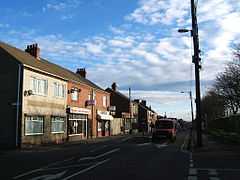Blackhall Colliery
| Blackhall Colliery | |
 Main street at Blackhall Colliery |
|
 Blackhall Colliery | |
| Unitary authority | County Durham |
|---|---|
| Ceremonial county | County Durham |
| Region | North East |
| Country | England |
| Sovereign state | United Kingdom |
| Post town | Hartlepool |
| Postcode district | TS27 |
| Dialling code | 01429 |
| Police | Durham |
| Fire | County Durham and Darlington |
| Ambulance | North East |
| EU Parliament | North East England |
| UK Parliament | Easington |
| |

Blackhall Colliery is a village on the North Sea coast of County Durham, in England. It is situated on the A1086 between Horden and Hartlepool. To the south of the Blackhall Colliery's Catholic church is Blackhall Rocks.
Built around the once extensive mining industry, Blackhall's colliery closed in 1981. There is now an industrial estate built over part of the old colliery buildings, the colliery itself was pulled down in the 1980s. [1] Blackhall Colliery is on the edge of Castle Eden Dene, and Castle Eden Dene Mouth.
Over the past couple of decades, there have been many changes. Following the closure of the colliery, the once busy village has economically gone downhill. As time has passed since the closure, other industries have now begun to emerge to once again create employment in the region.
With both Blackhall Colliery and Blackhall Rocks being on the main road to Peterlee and Hartlepool. This has meant that these villages have become commuter villages, supplying workers for the now busy and expanding call centres in the nearby towns of Hartlepool and Peterlee.
Blackhall beach

Blackhall beach made a notable appearance in the 1971 film Get Carter starring Michael Caine; in the climactic scenes the main character is involved in a chase across a coal-strewn beach.[2][3]
The film shows the beach black with coal spoilings, dumped there by mine's conveyor system. Since the mine closed, £10 million has been spent removing the conveyor and its massive concrete tower and cleaning tons of coal waste from the now pristine beach. [4]
Neighbouring beaches of Blackhall Colliery is Horden beach (North) and Crimdon beach (South), both are within 30 minutes of walking distance each way from the beach. The continuation of the improving regenerative beach can be seen via the coastline.
Allotments

Blackhall Colliery has a garden association, which is located around 500 yards inland from the beach front. The garden association consists of around 250 gardens covering six alleyways.
The allotments are continually improving security within the area as vandals and binge drinkers tend to hang out around the site before making their way to the beach. Added security like gates and security cameras help reduce vandalism and unwanted trespassing.
There has been an increase in rabbit and foxes within the allotments that residents of the gardens are aware of, crops tend to get destroyed or damaged which leads to hunters in hunting prey to keep the numbers down!
Fisherman normally park up in the allotment car park and head down to the beach front since there is no access to the beach banks, the allotments had a big car park bay for around 20 cars and a smaller car park on entry to the gates for about 5 to 10 cars.
There is big demand for allotments and a waiting list is scheduled in priority of people who put their names down on a first come first served basis, there is on average a 1 year waiting list.
Photo gallery
-
Blackhall beach
-

Overlooking Blackhall gardens
-

Blackhall gardens
-
Facing Seaton and Hartlepool
-
Standing on top of Blackhall bridge facing towards Hartlepool
-

Blackhall colliery
-

Monument to the mining industry at Blackhall Colliery
References
- ↑ "Blackhall Colliery", SINE project (Structural images of the north east), Newcastle University
- ↑ "The 50 best beach scenes in the movies", The Daily Telegraph, 23 August 2008
- ↑ "Hoping to get Caine for coastal spectacle", The Northern Echo, 28 August 2000.
- ↑ "Northern revival", Richard Nelson, The Guardian, February 16 2002
External links
- Blackhall Colliery from the Durham Mining Museum
| ||||||||


